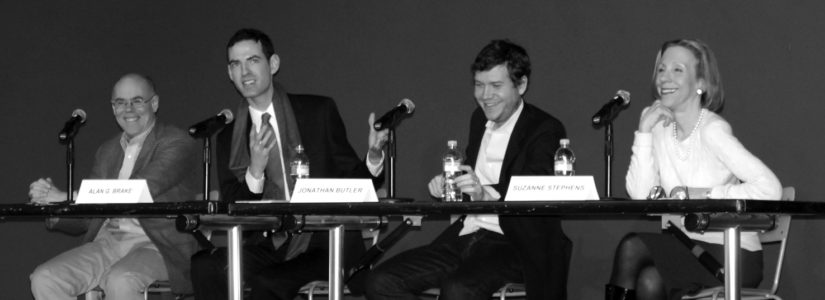
Preserving New York–Then and Now
February 23, 2008
Museum of the City of New York
The media, the civic sector, development, and advocacy were some of the topics that the distinguished roll of speakers and panelists addressed at the “Preserving New York–Then and Now” symposium held on February 23, 2008 at the Museum of the City of New York. The sold-out event, with over 250 in attendance, began with a welcome by MCNY Director Susan Henshaw Jones, and introductions by author Anthony M. Tung and Lisa Ackerman, Executive Vice President and COO of World Monuments Fund. In the keynote “The Past is Not Dead, It is Not Even Past,” Anthony C. Wood challenged the audience to question whether we are still losing buildings because of changing societal dynamics that preservation has failed to recognize and respond to. He also asked whether we’ve become too dependent on one tool—the landmarks law. The first panel featured Manhattan Borough Historian, Mike Miscione, architectural historian Andrew Dolkart, and cultural preservationist Ned Kaufman and addressed the question “Where Did the ‘History’ Go in Historic Preservation?” Mr. Miscione used Hamilton Grange and Grant’s Tomb to argue that historic preservationists have focused too much on architectural preservation and have not been effective in protecting places of mainly historic importance. Mr. Dolkart argued against Miscione’s point, countering with the example of the preservation of the Tenement Museum, a place of importance chiefly for public history. Mr. Dolkart compared Landmarks Preservation designation reports from the early years of the LPC to recent designations to argue that preservationists now take a more integrative approach, seeking to highlight places’ historical, architectural, and cultural values. Ned Kaufman offered examples from Australia and Buenos Aires for preserving places that hold intangible or associative cultural value, such as Bohemian Hall in Queens. New York State Council on the Humanities Senior Program Officer Jane McNamera moderated discussion following the presentations.
The second panel featured Suzanne Stephens, Deputy Editor of Architectural Record representing traditional media, Jonathan Butler, Founder and Editor of Brownstoner.com, representing the blogosphere, and Alan G. Brake, Associate Editor of The Architect’s Newspaper, a five-year old periodical that has a strong commitment to the web, representing the middle ground. Moderator Francis Morrone, architectural critic and journalist, facilitated the conversation on the historic and contemporary roles of the media in preservation. Ms. Stephens addressed the architectural criticism at The New York Times during Ada Louise Huxtable’s tenure as compared to the writings of her successors. Mr. Butler spoke about the immediacy and interactive nature offered through blogs and the ability of this media to concentrate the focus on preservation and development issues within a community, as with the case of 70 Lefferts Place in Clinton Hill. Mr. Brake spoke about the ability of The Architects Newspaper to be a forum to discuss timely issues in a traditional print format. While there is a void left by traditional media sources, new media and innovative applications of conventional publishing methods have created a necessary forum for preservation issues.
Following lunch, Mary Schmidt Campbell, Chair of the New York State Council on the Arts introduced the session “Preservation and Progress,” a dialogue between architect and Dean of the Yale School of Architecture, Robert A.M. Stern and renowned historian Kenneth T. Jackson, moderated by Anne Van Ingen, NYSCA Director of Architecture, Planning, and Design. Stern discussed preservation’s role in growth and development of SoHo, following the neighborhood’s journey from reclamation by artists beginning in the 1960s to its current state, presenting a positive view of preservation’s role in the City’s development. Mr. Jackson took an opposing view, purposefully, he said, overstating his case that what makes New York City a world class city is not its architecture, but its cultural richness and constantly changing nature and that preservation impedes this progress.
The third panel of the day sought to address “Preservation Advocacy Over the Decades.” In his slide presentation, Randall Mason, Associate Professor in the Graduate Program in Historic Preservation at the University of Pennsylvania, asked not to be called a preservationist, arguing that “ist” implied a radical, fundamentalist stance that sometimes hurts preservation advocates’ cases. Melissa Baldock, Director of Preservation and Research at the Greenwich Village Society for Historic Preservation offered a comparison of the advocacy campaigns in Greenwich Village today with those of the nascent preservation movement in the 1950s and 1960s.
In the final panel, “The Preservation Civic Sector in Times of Change” the audience heard from Executive Director of GVSHP, Andrew Berman, Director of the Building Movement Project, Frances Kunreuther, and architect and co-founder of the Douglaston & Little Neck Historical Society, Kevin Wolfe. Both Mr. Berman and Mr. Wolfe offered thoughts on the civic sector’s role in preservation from the perspectives of place-specific civic groups. Ms. Kunreuther stressed the importance of alliance building among civic groups in order to achieve preservation objectives.
Author and Visiting Scholar at NYU’s Wagner School of Public Service, Tony Hiss, had the challenging task of serving as the Rapporteur summarizing and digesting the day’s proceedings and lessons. With humor and eloquence, Mr. Hiss recounted the day and offered some thoughts for the future.
Throughout the day, the energy of the sold-out crowd was undeniable. It is clear that the questions raised by presentations, panel discussions, and the audience are ones that lovers of NYC will have to work together to answer in planning for the future. As Mr. Hiss stated, “Preservationists have been thought to be concerned with the bone—the bricks and mortar of a place— than the heart and soul, but their true underlying passion and commitment has been to the hearts and souls and to the lifeblood of the City of New York.” “How can we let this area grow and not lose its soul?”
Location:
Museum of the City of New York
1220 5th Ave
New York, NY 10029
Google Maps


